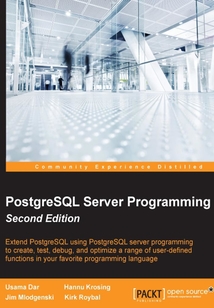舉報 

會員
PostgreSQL Server Programming(Second Edition)
最新章節(jié):
Index
ThisbookisformoderatetoadvancedPostgreSQLdatabaseprofessionalswhowishtoextendPostgreSQL,utilizingthemostupdatedfeaturesofPostgreSQL9.4.Forabetterunderstandingofthisbook,familiaritywithwritingSQL,abasicideaofquerytuning,andsomecodingexperienceinyourpreferredlanguageisexpected.
目錄(136章)
倒序
- coverpage
- PostgreSQL Server Programming Second Edition
- Credits
- About the Authors
- About the Reviewers
- www.PacktPub.com
- Support files eBooks discount offers and more
- Preface
- What this book covers
- What you need for this book
- Who this book is for
- Conventions
- Reader feedback
- Customer support
- Chapter 1. What Is a PostgreSQL Server?
- Why program in the server?
- About this book's code examples
- Moving beyond simple functions
- Managing related data with triggers
- Auditing changes
- Data cleaning
- Custom sort orders
- Programming best practices
- Caching
- Wrapping up – why program in the server?
- Summary
- Chapter 2. Server Programming Environments
- Cost of acquisition
- Availability of developers
- Licensing
- Predictability
- Community
- Procedural languages
- Summary
- Chapter 3. Your First PL/pgSQL Function
- Why PL/pgSQL?
- The structure of a PL/pgSQL function
- Conditional expressions
- Returning a record
- Acting on the function's results
- Summary
- Chapter 4. Returning Structured Data
- Sets and arrays
- Returning sets
- Using a set returning function
- Functions based on views
- OUT parameters and records
- A summary of the RETURN SETOF variants
- Returning cursors
- Other ways to work with structured data
- Summary
- Chapter 5. PL/pgSQL Trigger Functions
- Creating the trigger function
- Working on a simple "Hey I'm called" trigger
- The audit trigger
- Disallowing DELETE
- Disallowing TRUNCATE
- Modifying the NEW record
- The immutable fields trigger
- Controlling when a trigger is called
- Visibility
- Variables passed to the PL/pgSQL TRIGGER function
- Summary
- Chapter 6. PostgreSQL Event Triggers
- Use cases for creating event triggers
- Creating event triggers
- Creating an audit trail
- Preventing schema changes
- A roadmap of event triggers
- Summary
- Chapter 7. Debugging PL/pgSQL
- Manual debugging with RAISE NOTICE
- Visual debugging
- Summary
- Chapter 8. Using Unrestricted Languages
- Are untrusted languages inferior to trusted ones?
- Can you use untrusted languages for important functions?
- Will untrusted languages corrupt the database?
- Why untrusted?
- Quick introduction to PL/Python
- Thinking out of the "SQL database server" box
- Summary
- Chapter 9. Writing Advanced Functions in C
- The simplest C function – return (a + b)
- Adding functionality to add(int int)
- Basic guidelines for writing C code
- Error reporting from C functions
- Running queries and calling PostgreSQL functions
- Handling records as arguments or returned values
- Fast capturing of database changes
- Doing something at commit/rollback
- Synchronizing between backends
- Writing functions in C++
- Additional resources for C
- Summary
- Chapter 10. Scaling Your Database with PL/Proxy
- Creating a simple single-server chat
- Dealing with success – splitting tables over multiple databases
- Connection Pooling
- Summary
- Chapter 11. PL/Perl – Perl Procedural Language
- When to use PL/Perl
- Installing PL/Perl
- A simple PL/Perl function
- Passing and returning non-scalar types
- Writing PL/Perl triggers
- Untrusted Perl
- Summary
- Chapter 12. PL/Tcl – Tcl Procedural Language
- Installing PL/Tcl
- A simple PL/Tcl function
- Passing and returning arrays
- Passing composite-type arguments
- Accessing databases
- Writing PL/Tcl triggers
- Untrusted Tcl
- Summary
- Chapter 13. Publishing Your Code as PostgreSQL Extensions
- When to create an extension
- Unpackaged extensions
- Extension versions
- The .control file
- Building an extension
- Installing an extension
- Viewing extensions
- Publishing your extension
- Installing an extension from PGXN
- Summary
- Chapter 14. PostgreSQL as an Extensible RDBMS
- What can't be extended?
- Creating a new operator
- Creating index access methods
- Creating user-defined aggregates
- Using foreign data wrappers
- Summary
- Index 更新時間:2021-07-23 20:37:08
推薦閱讀
- 微信公眾平臺與小程序開發(fā):從零搭建整套系統(tǒng)
- R語言游戲數據分析與挖掘
- UML+OOPC嵌入式C語言開發(fā)精講
- SEO智慧
- 21天學通C++(第6版)
- Linux環(huán)境編程:從應用到內核
- UVM實戰(zhàn)
- 蘋果的產品設計之道:創(chuàng)建優(yōu)秀產品、服務和用戶體驗的七個原則
- Service Mesh實戰(zhàn):基于Linkerd和Kubernetes的微服務實踐
- JavaScript動態(tài)網頁編程
- Arduino計算機視覺編程
- ActionScript 3.0從入門到精通(視頻實戰(zhàn)版)
- 單片機原理及應用技術
- 零基礎學Java第2版
- 一覽眾山小:ASP.NET Web開發(fā)修行實錄
- 微信公眾平臺開發(fā)最佳實踐
- Java EE 程序設計
- Visual C++實用教程
- C語言開發(fā)入門教程
- JavaScript啟示錄
- 移山之道:VSTS軟件開發(fā)指南
- FreeSWITCH權威指南
- JVM G1源碼分析和調優(yōu)
- 敏捷開發(fā)的藝術
- Android應用測試與調試實戰(zhàn)
- Visual Basic 2008應用程序開發(fā)實例精講
- 編程大講壇:Java核心開發(fā)技術從入門到精通
- Clojure Web開發(fā)實戰(zhàn)
- IBM Informix 11.x系統(tǒng)管理與開發(fā)指南
- 程序是怎樣跑起來的

